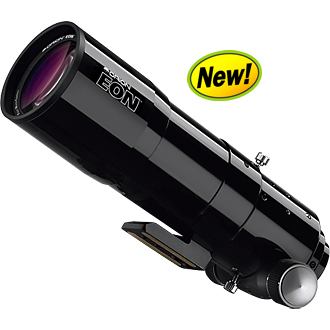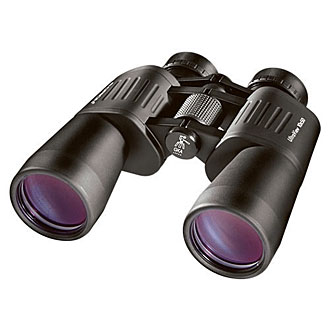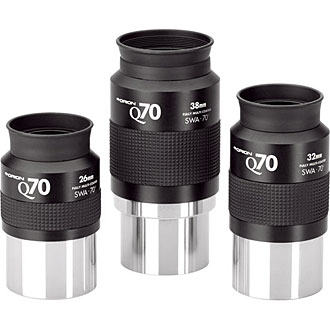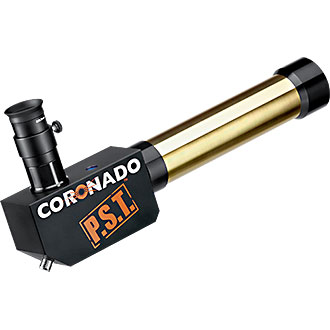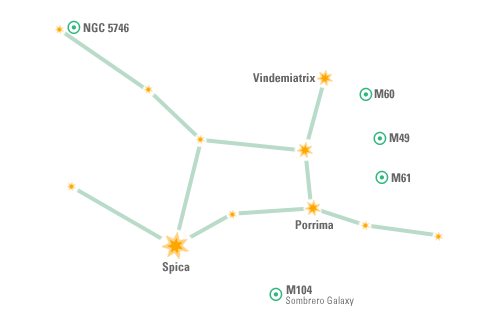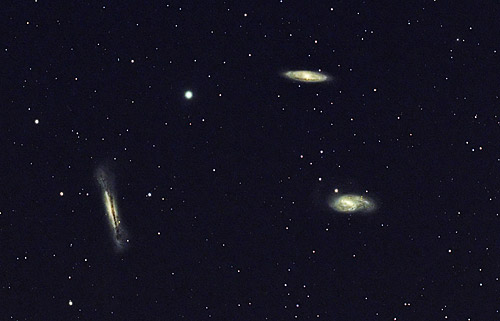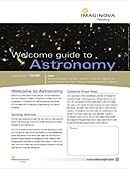 |
||||||||||||||||||||||||||||||||||||||||||||||||||||||||||||||||||||||||||||||||||||||||||||
|
If you have trouble viewing this newsletter, click here. Welcome again to our monthly newsletter with features on exciting celestial events, product reviews, tips & tricks, and a monthly sky calendar. We hope you enjoy it!
“In spring a young astronomer’s fancy lightly turns to thoughts of…” It’s spring where I live, a very short-lived season in southern Canada; remnants of snow in the woods, yet I've already swatted my first mosquito. The spring sky is also short-lived because of the Sun’s rapid travel northwards at this time of year. It seems as if winter’s brilliant constellations are replaced by the summer ones in a few short weeks.
It’s now warm enough at night to be able to spend a couple of hours in relative comfort with the stars. This is a good time of year to begin new observing projects. If you’re a newcomer to astronomy, you might enjoy the Royal Astronomical Society of Canada’s “Explore the Universe” program. You don’t have to be a member to participate; just download the program brochure and get started. It will introduce you to the wide variety of objects in the night sky, and won’t take you forever to complete. All you need for most of it is your naked eye, a small pair of binoculars, and a reasonably dark sky. If you’re more advanced in astronomy, you might take on a more challenging project, such as observing all of the 110 objects in Charles Messier’s catalog of deep sky objects. These include the brightest and best objects in the northern sky, and is considered “basic training” for deep sky observers. All the objects are plotted in Starry Night®. Spring is also the time for spring cleaning. It’s a good time to make sure your astronomical equipment is tuned up and ready to perform at its best. Please note that this usually doesn’t involve cleaning your telescope’s main lens or mirror. Unless you follow very careful procedures, you’re more likely to do damage to your optics than to improve the view. A bit of dust won’t do any harm. What is required is an optical tune-up, called collimation, to make sure your telescope’s optics are properly aligned. This is primarily required by Newtonian reflectors and Schmidt-Cassegrains; refractors and Maksutovs are factory aligned and best left alone unless you really know what you’re doing. Collimation is a painless procedure once you’ve done it a few times; your telescope’s operating manual should contain all the information you need. For Newtonians, a simple collimating eyepiece is a handy aid. Spring is also a time when many amateur astronomers start leafing through the ads and catalogs of the various manufacturers looking for new hardware to enhance their viewing experience. Every telescope is a compromise of some kind, so many astronomers end up owning more than one telescope. If you already own the large Dobsonian reflector which most of us recommend for beginners, you might consider a small “grab-and-go” refractor which will give you wide field views, such as Orion’s new Eon series. I’m always surprised at how many amateur astronomers own a telescope but not a pair of binoculars. I personally find binoculars to be an indispensable part of my observing “kit.” Not only are they a wonderful observing tool in their own right, giving wide rich fields of view without the hassles of mounts and finders, but they are also an essential part of finding objects by starhopping. A pair of binoculars with the same field of view as your telescope’s finder allows you to practice a starhop comfortably before attempting it with finder and telescope. I own several different sizes of binoculars, but find that I use my 10x50s more than any other size: light in weight, easy to hand hold, and very wide field. If you become really addicted to binocular views, you might want to invest in a pair of giant binoculars. Because of their weight and magnification, these usually need to be mounted on a tripod, but Orion offers several alternatives to make this an easy process. Most scopes come with one or two basic eyepieces, usually 25 mm and 10 mm Plössl types. These are fine to get you started, but they only hint at the versatility of which an astronomical telescope is capable. After you’re comfortable using these basic eyepieces, you may want to increase your range with a low power wide field eyepiece such as Orion’s new Q70 2” super wide angles. At the other end of the scale, you may want to get up close and personal with the Moon and planets with a specialized planetary eyepiece like Orion’s new Edge-On series. You may choose this spring to embark on a totally new area of astronomy. Many astronomers concentrate on the stars visible at night, but forget the star closest to us, the Sun. After passing through its minimum activity, part of its 11-year cycle, the Sun is now starting to get active again, with sunspots increasingly common. A solar filter on the front of your telescope will let you watch these change as they rotate across the face of the Sun. You may also want to explore the solar flares and prominences visible with a dedicated Hydrogen Alpha telescope like this: Another area to explore is astrophotography. Most telescopes can easily be coupled with today’s digital cameras to photograph the Sun, Moon, and bright planets. If your scope has a motorized equatorial mount, you can easily make “piggyback” images by mounting your camera on the piggyback bolt included on the tube rings of many mounts. Consider adding one or more neat little accessories which will enhance your observing experience. I’ve recently discovered the joys of the Orion Waist Case, which lets me keep my most used eyepieces and filters right on my person. For years I “made do” with a variety of flashlights, but once I discovered the Orion Dual Beam flashlight, it’s the only one I use, and it’s always handy hanging around my neck on its built-in loop. There were lots of handy gadgets, including both of these, listed a few issues ago in Starry Night® Times. However you choose to celebrate spring fever, get out there and enjoy these pleasant spring evenings! Geoff Gaherty
There is one special day in the year when astronomers get to strut their stuff and invite the general public to “share the view.” This year Astronomy Day falls on Saturday May 10, and there will be events all around the world to celebrate our favorite hobby. There’s a good summary of what Astronomy Day is all about, along with listing of events all around the United States, on this web page. And here's a similar page for Canadian events. If you’re new to astronomy, Astronomy Day gives you a chance to experience a star party, and look through telescopes of different kinds. If you’re an old timer, you’re probably already participating in your club’s events, but there’s an opportunity here for everyone to help get newcomers involved. Contact your local school or library to see if they are interested in hosting an event. There are plenty of resources available online, including our very own Welcome Guide to Astronomy, which you can download, print out, and distribute free of charge. Probably the greatest experience you can offer to a newcomer is the chance to look through a telescope at some favorite objects in the sky. Even though we astronomy regulars may drool over faint galaxies, such tough objects are usually lost on the general public. From my experience at dozens of star parties, I can guarantee that the most popular objects for most people are the Moon and planets, especially Jupiter and Saturn. On May 10, a 6-day-old Moon will be perfectly placed for viewing with any telescope, as will the ringed planet Saturn. I like to point out Saturn’s brightest moons in addition to the more obvious rings. Starry Night® will print out a view of Saturn and its moons to help you identify them. Bright Titan, easily visible in any telescope, will be at the east side of the planet, and Rhea, the second brightest Moon will be on the west side.
Double stars are popular targets at Astronomy Day star parties. Algieba, located directly above Saturn and Regulus in Leo, is one of the finest double stars in the sky. The information in Starry Night® will give you some interesting things to tell people about this pair of stars. They are located 126 light years away from us and revolve around each other once each 620 years. A magnification of 100x should be enough to split these two stars. Open clusters are popular showpieces at low magnification. The Beehive in Cancer (Messier 44) is a fine example. Cancer is a dim constellation, usually making it hard to find, but on May 10 the Beehive will be right next to the Moon, making for a really spectacular view in a wide-field eyepiece or even binoculars.
If you have a large aperture scope available, three of the biggest and brightest globular clusters will be rising in the east: Messier 3 in Canes Venatici, Messier 5 in Serpens, and Messier 13 in Hercules. Again, refer to Starry Night® to get some interesting information to pass on to your visitors. Have a great Astronomy Day! Geoff Gaherty
Don't let the scale of the diagram above fool you. Representing the goddess of justice, Virgo is the second largest constellation in the sky. Spica, a first magnitude blue-white star, is easy to spot, shining as it does in a fairly dark part of the sky. M49 and M60 are elliptical galaxies. Being one of the brightest ellipticals, M49 was the first member of the Virgo-Supercluster to be discovered by Charles Messier. M60 is some 60,000,000 lightyears distant and is as luminous as 60 billion copies of our sun. Most of the galaxies in Virgo are part of the Virgo-Supercluster. Not so M104. At about 50,000 lightyears, this galaxy's dark dust lane and close to edge-on angle (just 6°) makes it look a little like a sombrero. M61 is a lovely face-on spiral galaxy while NGC 5746 is an edge-on spiral galaxy that's best observed in small scopes. Finally, Porrima is a fine double-star worthy of a peek. Sean O'Dwyer
Leo Triplet - M66 Group by W. Garrett Grainger, Jr. Taken March 2, 2008 This small group of galaxies consists of the Messier objects M65 (NGC 3623) and M66 (NGC 3627) as well as the edge-on spiral NGC 3628.
PRIZES AND RULES: We would like to invite all Starry Night® users to send their quality astronomy photographs to be considered for use in our monthly newsletter.
Please read the following guidelines and see the submission e-mail address below.
|
MAY 2008
|
|||||||||||||||||||||||||||||||||||||||||||||||||||||||||||||||||||||||||||||||||||||||||||
 |
||||||||||||||||||||||||||||||||||||||||||||||||||||||||||||||||||||||||||||||||||||||||||||
|
|
||||||||||||||||||||||||||||||||||||||||||||||||||||||||||||||||||||||||||||||||||||||||||||
You have received this e-mail as a trial user of Starry Night® Digital Download
or as a registrant at starrynight.com. To unsubscribe, click here.

